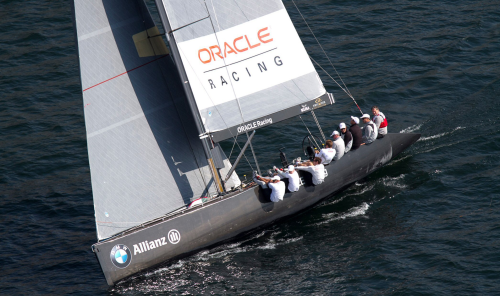
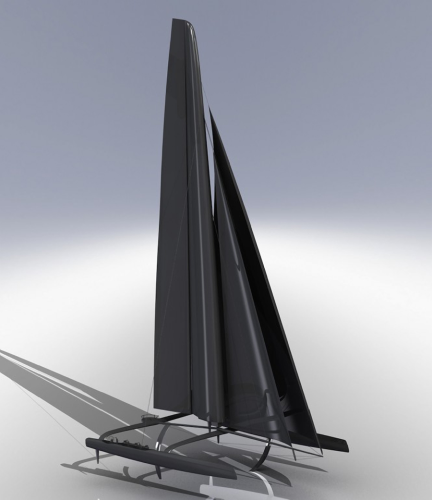
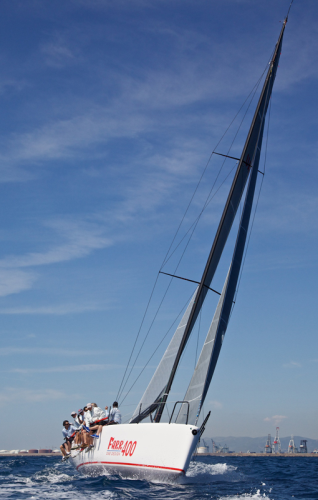
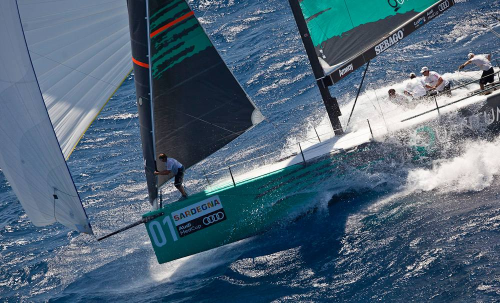
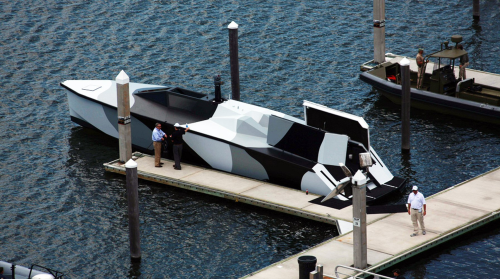
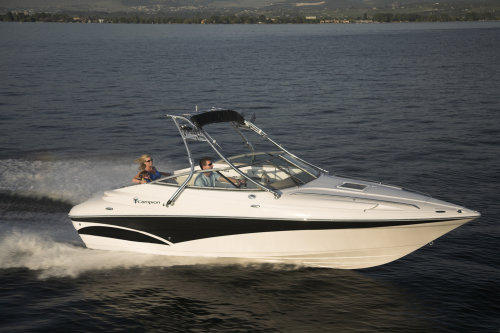
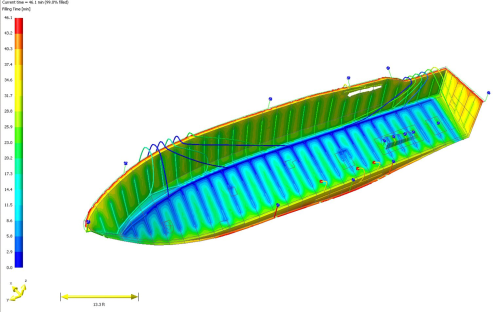
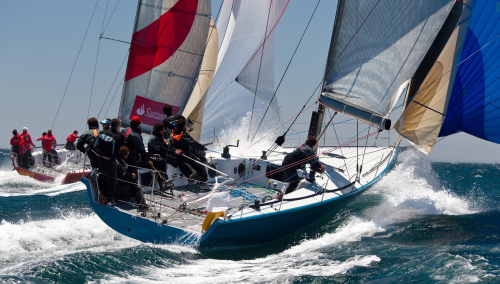
Worldwide the recreational boat building industry hit bottom in 2009 due to the global recession. Retail sales of new boats in the US dropped from a high of 311 700 in 2007 to a low of 153 550 in 2009, according to the National Marine Manufacturers Association (NMMA). Sales started back up last year, with new boat registration numbers totalling 282 615, reports NMMA.
Europe and the United States are the largest markets for recreational boats. Europe leads in sailboats and the US in powerboats. The majority have hulls, decks and other components of fibre reinforced plastics (FRP). Globally, the recreational boat market consumed 365.3 million lbs of composites valued at US$524.3 million in 2009, according to a Lucintel market report. The researchers expect that to climb to $842 million in 2015. An ongoing shift is seen in the boating product mix toward larger and more expensive boats.
An industry study from Freedonia, Recreational Boating to 2014, predicts that the US recreational boating market will rebound from depressed 2009 levels and grow 9.3% annually to $10.1 billion in 2014. The growth will come from economic and credit market recoveries, dealer restocking and pent-up demand from consumers who have delayed purchases during the downturn, says Freedonia.
Brunswick Boat Group, a US manufacturer of 16 boat brands, offers the broadest range of product offerings in the world, with boats ranging in size from 10 ft to 105 ft (3 m to 32 m). The company announced that net sales in the second quarter of 2011 were up 10% versus the same period in 2010, reflecting a more stable retail marine market in response to solid demand and market share gains.
IBEX draws crowd
The marine marketplace was in the spotlight in October, when the 2011 edition of the International Boat Builders Exhibition and Conference (IBEX) brought boat manufacturers, designers, repairers, dealers and suppliers together in Louisville, Kentucky, USA. The three-day trade show drew more attendees and presented more exhibits in a larger space than last year. Over 500 exhibitors were on hand at the show, and more than 90 seminars were offered, including 11 in the Composites Methods & Materials track.
The Composites Pavilion featured more than 100 exhibitors. Composites One, the leading North American distributor of composites materials, presented a workshop on The Closed-Mould Decision, which discussed various aspects, factors and tools involved in switching over from open mould to closed mould processing. Demonstrations of closed moulding technologies, showcasing cutting-edge materials and process improvements, were presented by Composites One along with equipment and material supplier Magnum Venus Plastech (MVP) and members of the Closed Mold Alliance, a group of equipment manufacturers and material suppliers.
One demonstration involved the Flex Molding infusion process developed by MVP, which was introduced last year at IBEX. It integrates a comprehensive package of injection systems, accessories and patent-pending sealing specifically designed to optimise infusion. Flex Molding is said to achieve an unmatched level of precision, while eliminating consumable tubing and fittings, while avoiding the need to pre-mix resin.
Another IBEX demonstration programme of interest to moulders involved spray-on reusable silicone vacuum bags for infusion and autoclave prepreg processing. SWORL, a division of Prairie Technology Group (PTG) in Texas, presented the programme. (SWORL is short for Sprayable Repairable Reusable Vacuum Bags.) PTG recently introduced the Retro V, a wide-flange converter that enables processers to use narrow-flange tooling for CCBM (Closed Cavity Bag Moulding), a patented vacuum infusion system which requires wide flanges for proper sealing.
Interest in closed moulding continues strong, relates Marcy Offner, Manager, Composites One Marketing Communications.
“We’re experiencing great success with our closed mould programme,” she says. “Sales each year continue to build upon the year before. While the marine industry as a whole has struggled over the last few years, our closed mould sales have continued to grow. I think it has to do with the desire to reduce emissions and streamline processing for more cost-effective operations.”
New composites products
A new high-performance prepreg from SP-High Modulus, the marine business of global composite materials supplier Gurit, has been developed for marine applications where compressive performance is a key requirement. SE 84 Nano, a hot-melt epoxy prepreg, is said to exhibit a 20% increase in compressive strength when vacuum bag moulded as compared with SP-High Modulus SE 84LV.
The mechanical properties improvement has been achieved through proprietary formulation technology and 3M™ Matrix Resin, reports the manufacturer. SE 85 Nano is compatible with vacuum bag, press-moulding, autoclave and other pressure-moulding processes. The prepreg can be used in sandwich structures with honeycomb and foam and retains compatibility with the toughened SA 80 Adhesive Film, notes SP-High Modulus.
Another recent introduction from SP High-Modulus is Corecell™ M-Foam, a cost-effective structural foam core offering high shear strength, low weight/high elongation, low resin uptake for infusion processes and high temperature stability for prepreg processes. Calling it the performance leader for all types of marine applications and a replacement for polyvinyl chloride (PVC) cores, the manufacturer reports that Corecell M-Foam offers superior uniformity through lower density variation and is compatible with polyester, vinyl ester and epoxy resin systems.
Growing in popularity, especially among production boat builders, is the B3 SmartPac kitting solution from SP-High Modulus. Each SmartPac contains all the reinforcement and core materials required for a project, pre-cut to the exact size and shape required to fit the mould and packed in boxes in the order of assembly. Each kit is accompanied by a comprehensive schematic and construction manual as well as description of the moulding process and integral quality control systems.
DIAB Group, the Sweden-based global supplier of composite sandwich materials, recently introduced Divinycell Matrix 11-9 foam core, designed to provide excellent strength-to-weight performance with outstanding mechanical properties. No other core material has been commercially available with the mechanical properties at such a low density as Matrix 11-9, relates DIAB.
DIAB has also increased the mechanical properties of Matrix 7-7, making the foam core suitable for an even wider range of applications. For boats, the product is said to be among the lightest foam cores meeting the DNV requirements for decks. Both Matrix 11-9 and 7-7 are available in a wide range of finishing options and kits.
Improving boat quality
Scott Bader, a UK-based multinational chemical company, has introduced Crystic® Permabright, a new D-Iso/NPG spray and brush gel-coat formulated for improved ultraviolet (UV) weathering performance. The advanced polymer resin technology is unique to the manufacturer. Test results demonstrate that the gel-coat can provide two times better colour stability than the next best in its class iso/NPG gel-coat and four times better than a standard isophthalic gel-coat, says the manufacturer. In rigorous blister tests, Crystic Permabright showed no signs of blistering and it exhibited very low water uptake after 12 months immersion, reports Scott Bader.
Lantor Composites, manufacturer of flexible core materials, offers Coremat® and Soric® product lines for improving the surface quality of composites. They are used as liners and print blockers to prevent the print-through of heavier structural reinforcements or cores in boat hulls and other marine components. Also, the Inter-laminar Flexible Core Lantor Soric XF 6 mm is said to be well suited for vacuum infusion and resin transfer moulding (RTM) processing as a combination structural core and resin flow medium. Lantor Soric TF is often used in combination with a skin coat for improved surface quality and can also be used to replace the skin coat altogether.
Award-winning Prisma Strip Plank Technology (SPT) from Structural Composites and sister company Compsys, both of Melbourne, Florida, USA, is used to produce structural preforms that incorporate glass fibre knit fabrics and flotation-grade polyurethane foam. The lightweight composite components are laminated onto boat surfaces to help support dynamic loads and prevent hull and deck failures. SPT was awarded a 2010 IBEX Innovation Award in the Boatbuilding Methods and Materials category. Strip plank structural preforms can reduce cost and simplify construction of cockpits, decks and hardtops, the company says.
Carbon composites for racers
The strength, stiffness and weight benefits of carbon fibre composites make them a favourite of racing sailboat designers, who are typically less concerned about cost of materials than performance gains. Farr Yacht Design collaborated with Dubai-based Premier Composite Technologies (PCT) to build the next-generation Farr 400, an all-carbon, one-design racing yacht using vacuum infusion with epoxy sandwich construction. Pre-cut and numbered reinforcements and core materials were supplied in a B3 SmartPac from SP High-Modulus for production of the 12.2 m (40 ft) yacht.
Another light-displacement carbon production sailboat is the RC44, measuring 13.35 m (43.8 ft) long and displacing 3560 kg (7850 lbs). The hull, deck, structural liner, keel, rudder and sail rig were built using a sandwich composite of epoxy and carbon unidirectional and biaxial fabrics. Twill carbon woven roving was used on all external surfaces to give a smooth, clear, carbon-look finish.
Racing catamarans powered by rigid wing sails will compete in the 34th America’s Cup in San Francisco, California, in 2013. The AC72 one-design cats measure 72 ft (22 m) long overall and displace 13,000 lbs (5900 kg). They are built using honeycomb-cored carbon/epoxy sandwich composites, which are autoclave cured. The wing sail, a built-up structure with an airfoil cross section, similar to an airplane wing, is said to generate twice the speed of soft sails used in past America’s Cup races. High-modulus carbon material is used in the wing sails.
Oracle Racing, the American sailboat racing syndicate defending the America’s Cup, has been training on a smaller version of the AC72, the AC45. The 44 ft (13.45m) long AC45 boats are built in New Zealand by Oracle Racing’s boat building group, Core Builders Composites. An ultra-light honeycomb core is sandwiched between carbon skins that are less than 1 mm thick, and baked under vacuum pressure at 80°C. The AC45 displaces 3086 lbs (1400 kg).
Prepreg selection guide
|
The M-Boats boatyard in Argentina relied on technical assistance from SP-High Modulus and the B3 SmartPac to streamline the build process for a one-design racing yacht series, the Soto 40. Lucas Dittrich, production director, wanted to improve production efficiency and maintain the performance and weight properties of the next generation of the boats. He selected the B3 SmartPac, which provides all the pre-cut, numbered dry reinforcements and core materials needed for the build. More than two dozen of the first generation Soto 40 hulls were hand laid in open moulds, but Dittrich believed that a move to infusion technology would enable the yard to reduce the build time and maintain a consistent quality. He wanted to change the way they approached the build but maintain the performance of the boats so that both the first and second generation boats would be equals on water, which is critical to the match racing community. “Whilst I was familiar with the kitting concept, the SmartPac was the only offering on the market that really met all our requirements,” relates Dittrich. “I assessed all the benefits that we expected to get from using the system, and decided to give it a try. We have been thrilled with the results.” The M-Boats team no longer needs to spend time cutting the reinforcement and core materials. These are all supplied pre-cut, including the small areas of local patching and high-density core, in the SmartPac. The CNC-cut reinforcement pieces hold their shape far better than when cut by hand, and the infusion process is smoother due to the highly accurate fit of the materials in the mould, notes the supplier. “Our procurement process is far easier now as we do not have to order, ship and track different materials from around the world,” says Dittrich. “We simply order complete SmartPacs, which gives us one point of contact for logistics and one shipment to track.” Boat buyers also like the consistency and accuracy provided by the SmartPac approach to production, he notes. “It reassures them that each boat is built the same as the next.” |
Advanced Composites Group (ACG), a UK-based global supplier of advanced composites prepregs for marine applications, offers a Marine Product Selector Guide on its website to facilitate selection of materials for marine applications. ACG offers a range of glass fibre and carbon fibre prepregs as well as dedicated technical support. The guide includes mechanical performance and process methodologies of ACG products.
ACG’s VTM260 Series carbon prepregs are the composite material of choice of many racing boat builders. The hull and deck of the 54 ft (16.5 m) grand prix racing yacht Oystercatcher XXVIII were constructed of VTM260 prepregs in a sandwich construction. Foam core was used in the hull for toughness, and Nomex™ honeycomb in the deck and internal structures to reduce overall weight. The rig was produced with ACG’s MTM® Series ultra-high-modulus carbon fibre prepregs. Another successful racer built with ACG prepregs was the Quantum Racing Team’s entry in the recent 2011 Audi MedCup TP52 Circuit Series.
Amber Composites, a manufacturer of composite materials, received the Supplier of the Year Award for Technical Innovation from Sunseeker International, a leading luxury motor yacht manufacturer. Amber developed a new prepreg resin system for Sunseeker, Multipreg E520, which delivered the required strength, stiffness and light weight for a large, lateral hoop on the flybridge of the Manhattan 73. Multipreg E520 is an out-of-autoclave product that is easy to use and provides a high-quality cosmetic surface finish, says Amber.
Innovations on water
Nano-enhanced, carbon fibre-infused composite materials from Zyvex Technologies in Ohio, USA, were used to produce the first boat ever built using carbon nanotubes. The 54 ft (16.3 m) Piranha displaces only 8500 lbs (3856 kg), which compares to boats of similar size that typically displace 40 000 lbs (18.1 tonnes), relates Zyvex. Designed as an unmanned surface vessel for use in anti-piracy, anti-trafficking and similar operations, the Piranha offers an extended range of more than 2800 nautical miles and a payload of more than 15 000 lbs (6804 kg).
Zyvex Technologies has developed prepregs with nano-enhanced materials that provide significant weight advantages for increased fuel efficiency in vessels. Two lines of the high-strength, high-stiffness prepregs are available: Arovex 180, a 180°F cure, carbon nanotube-strengthened system; and Arovex 250, a 250-300°F system. Both are offered in widths up to 60 inches (1.5 m) for standard woven fabrics in carbon, E-glass, S-glass and aramid, an in unitape widths up to 24 inches. The materials are said to process as easily as conventional prepreg and have a 30-day outlife.
Black sails made of aramid fibres can now be produced for the first time, thanks to the new Twaron Black from Teijin Aramid. At the request of customers in the sailing and sports industries, Teijin developed a method to colour the fibre, which is naturally golden-yellow. Aramid fibres are difficult to dye, relates Teijin, so the production process was modified to inject them with black dye to produce a fibre with the same characteristics as the naturally coloured fibre.
Improving flame resistance
Crystic FireGuard 75PA Excel from Scott Bader adds flame retardancy to boats and other FRP structures. The product is applied as a topcoat on a boat’s inner surface, since its weather resistance is not as good as a standard polyester gel-coat. Testing has shown that Crystic Fireguard 75PA Excel can withstand a direct flame at 700°C for over 60 minutes. Princess Yachts International specifies the product wherever fire protection is required, noting that it is easy to apply and provides a first-class finish in addition to very high fire performance.
Another product designed to improve flame resistance is a new epoxy prepreg from Barrday Composite Solutions of Massachusetts, USA. Designed for interior applications, the new EP2052 prepreg is self-extinguishing, and passes both the 12- and 60-second vertical burn tests as listed in FAR 25.853. The prepreg, with an outlife of more than three weeks, is said to provide excellent structural properties. It offers a 20-minute snap cure at 255-275°F (125-135°C) for faster throughput than standard-cure systems.
3A Composites Core Materials, offering a broad portfolio of core products, has introduced a new fire resistant polyethylene terephthalate (PET) foam core, AIREX T90.210. This addition to the T90 family provides improved mechanical properties and high flame, smoke and toxicity (FST) ratings. Shear strength, shear elongation and compression modulus have been increased, while the density has been reduced, providing a 13% weight reduction.
Speciality marine resins
|
Composites Consulting Group (CCG), a consultancy to the marine and other industries, conducted a workshop on Composite Infusion Technology at the 2011 IBEX show in October. The benefits of closed moulding were discussed – elimination of VOC emissions, improved control of the laminate and better workplace environment. CCG works with clients, providing design and structural analysis, flow modelling, testing and training. Most boat projects they take on are 35 ft (10.7 m) and longer, up to 155 ft (47.2 m), relates James Jones, Manager, Americas Region. CCG recently consulted on the infusion for the hull and deck of an 80 ft (24.4 m) Sportfish by motor yacht builder Donzi Roscioli. “We designed the infusion manifold system, tested the permeability of the laminates and analyzed the resin flow using RTM-Worx software,” recounts Jones. “Then, our process specialists worked on site during the preparation and infusion of the hull and deck parts.” The hull used 10 drums of resin and filled in just under one hour. Discussing the trend toward closed mould processing, he notes that closed mould technologies date back to the 1950s. “But they just didn’t have the material technology back then to implement it as widely as it is today,” he notes. “In recent years, lower-viscosity resins have been developed with chemistries and cure profiles formulated specifically for closed moulding. That has made the change to these processes much easier.” In terms of cost, Jones observes that the higher efficiency of closed moulding is especially evident with large parts, which can be moulded faster and with smaller crews than by using hand lay-up in open moulds. |
AOC is respected by boat builders for its family of marine resins. Sea Ray, a manufacturer of sport boats, enlisted the expertise of AOC to develop a resin for its shift from open moulding to RTM. The boat builder was looking to improve tolerances, reduce material variance and produce stronger, more reliable boats. AOC developed Hydropel® R580-CUC. No veil is required to get a surface that is as good as or better than the surface of an open-moulded part, relates Sea Ray.
Low-HAP resins with reduced styrene levels for marine applications are also part of the AOC product family. Hydropel H034-A MACT-compliant vinyl ester is used by powerboat manufacturer Chaparral Boats as a skin coat to provide resistance to osmotic blistering. Behind the skin coat, the boat builder applies a laminate of glass fibre reinforcement in AOC’s Altek® H834-R resin. That provides a fast cure rate, reduced post-cure and a high heat deflection temperature for higher production rates with an excellent surface profile, notes AOC.
Bio-materials for boats
Bio-resins and reinforcements continue finding their way into the marine market. Campion Marine, Canada’s largest fibreglass boat builder, announced last year that it planned to use only Envirez® bio-based resin from Ashland Performance Materials for new boat construction. Campion manufactures 37 models of high-performance sport boats and cruisers.
“We’re putting Envirez resin in all our boats, not only because of its superior performance relating to strength and elongation, but because it’s the right thing to do for our world,” stated Campion General Manager Brock Elliott.
The company built its first glass/bio-resin boat in 2008. Two years of testing confirmed that the resin would meet Campion’s standards. Envirez is the first commercially available unsaturated polyester resin containing a significant quantity of renewable materials, says Ashland.
An ‘all natural’ canoe built using Biotex Flax from Flaxland in the UK is undergoing long-term durability and water-resistance testing. A layer of Biotex Flax Hopsack weave and a UV-cured resin, EcoComp UV-L from Sustainable Composites in the UK, were used over marine plywood and a pine framework to build the ultra-lightweight canoe. The EcoComp resin is linseed oil based.
Flax fibres were also used as reinforcement in a 6.5 m (21 ft) long sailing yacht prototype sponsored by Huntsman Advanced Materials. The composite material used to build the boat consisted of Huntsman’s Araldite warm-curing epoxy resin system reinforced with 50% flax fibres, pre-coated to prevent water absorption, and 50% carbon fibres. The flax was from Lineo, a Belgian manufacturer specialising in flax reinforcements. ♦
This article was published in the November/December 2011 issue of Reinforced Plastics magazine. To apply to receive your free copy of each issue of Reinforced Plastics please complete the subscription form.






